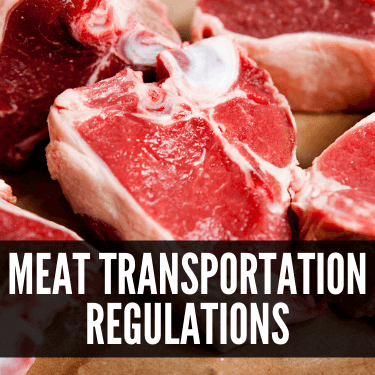Shipping meat, which includes lamb and mutton, is a huge business in the animal protein-loving United States. With the average American eating well over 200 pounds of meat per year, there is a large demand to get meat on the plate. So if you have a shipment of mutton and/or lamb that needs to get somewhere, there are some things you need to know.
The biggest aspect of shipping meat is knowing how to handle the product safely. Abiding by the Food and Drug Administration’s (FDA) regulations and understanding what temperatures to keep the meat at during shipping and storage is essential. With a little learning, shipping meat shouldn’t be a problem for your business.
The process can be even easier with the involvement of R+L Global Logistics, a third-party logistics company that can safely and quickly get your lamb and mutton transported wherever it needs to go.

First, it’s important to make the distinction of what the United States considers to be the difference between lamb and mutton. A lamb is generally thought to be one year or younger while most sheep slaughtered for mutton in America are between 1 and 2 years old. Still, anything older than 2 years is also mutton.
With a little over 5.2 million heads of sheep and lambs in the United States, sheep and lamb are a small yet important component of the livestock industry. A few states have a good chunk of the sheep kept in America for domestic purposes:
| Texas | 740,000 |
| California | 550,000 |
| Colorado | 365,000 |
| Wyoming | 355,000 |
| Utah | 275,000 |
Texas and California combined, account for almost 25 percent of the total sheep in the country. Also, while it didn’t make the top 5, South Dakota (270,000) is nipping at Utah’s heels for the fifth spot.
It is estimated that 70 percent of sheep grown in the United States will end up being exported, as the demand is much higher in other countries than it is in America. States within the U.S. also buy sheep from each other. Traditionally, sheep require more resources than cattle since they need to be free-range and require a lot of grass to graze on.
Mutton and lamb need special care when being shipped, as do most meats. In certain cases, it needs to be shipped overnight and packaged with dry ice to keep it sufficiently cold. Insulation also goes a long way, so enclosed crates or boxes can be used to store the meat. Some even wrap the containers in fabric in order to further insulate it.
Whatever you decide to use to store the meat, you need to make sure there are no leaks, that the proper temperature is maintained and the packaging isn’t damaged or unsanitary.
Partnering with a logistics company that takes this seriously is of the utmost concern. So when looking for a freight hauler that cares as much as you do about your meat, look no further than R+L Global Logistics. We’re experts in refrigerated shipping and can manage every aspect of your supply chain.

The United States Department of Agriculture (USDA) and the Food Safety and Inspection Service (FSIS) have comprehensive lists of guidelines for the transportation of meat.
The two regulatory bodies’ main goal is to eliminate the growth of bacteria and/or contamination that can come from the normal handling and transportation of meat. The Hazard Analysis and Critical Control Point (HACCP) system is designed to make sure appropriate temperatures are maintained at all times and that the “cold chain” is not broken from the time it leaves the slaughterhouse until it reaches grocery stores.
The USDA and FSIS also have general guidelines that touch on the proper sanitization and maintenance of the trucks, trains, boats or planes that might be used to transport meat. The USDA has even increased its desire for food security following the terrorist attacks of September 11, 2001, to help ensure any food being produced isn’t vulnerable to biological tampering.
Unsure how to ship live animals like cattle? Check out our article on transporting cattle safely.
Keeping lamb or mutton at the correct temperature is paramount for two reasons:
What temperature you keep your lamb and mutton at also depends on how it was processed.
Fresh meat products shouldn’t rise above 40 degrees Fahrenheit (4 degrees Celsius) at any point during the supply chain. The general rule of thumb is that transportation should take no more than two days with fresh meat so that it can arrive at a grocery store still in its best quality to sell. For this reason, fresh meat is not transported long distances.
Unlike water, meat doesn’t freeze at 32 degrees Fahrenheit. For meat to truly freeze and be properly stored for nearly unlimited times, it should be at 0 degrees Fahrenheit (-18 degrees Celsius) to maintain its overall quality and prevent nutritional loss or discoloration.
Processed meat can be shipped either fresh or frozen and should be shipped according to the guidelines established for each kind. As you can see, temperature control is very important to the quality and viability of the mutton or lamb commercially.
Once you’re prepared to begin shipping meat, the transportation experts at R+L Global Logistics are here to help start that process. We have been involved in hauling all kinds of lamb and mutton and can bring forth a solution that will work for you.
R+L Global Logistics handles every shipment with the necessary precaution and care so that you can have complete peace of mind. We are experts at making sure shipments are not late, as evidenced by our 99.5 percent on-time delivery rate. Included with our stellar delivery timing is our real-time freight visibility which allows you to know exactly where your load is at every step of the way.
We offer additional services for customers, such as expedited shipping for those times you need something shipped just a little faster than our normally speedy delivery. Also, rest assured that we follow the FDA’s transportation regulations to the letter. So when you’re ready to start shipping meat, contact us at (866) 353-7178 for a quick and transparent freight shipping quote.
R+L Global Logistics
315 NE 14th St., Ocala, FL 34470